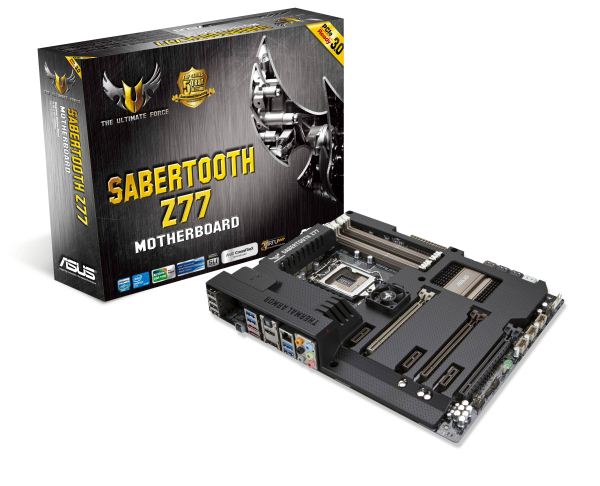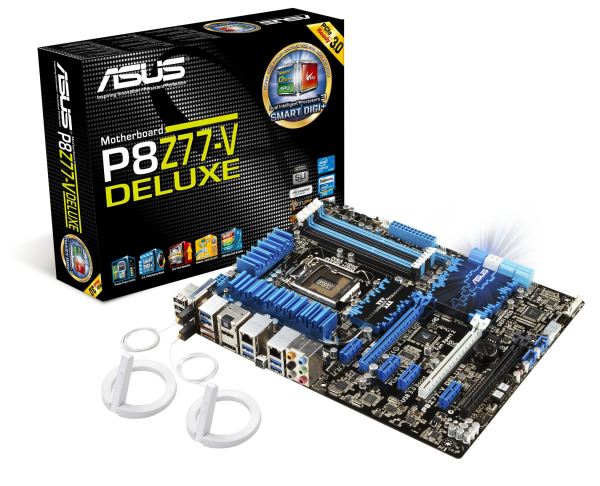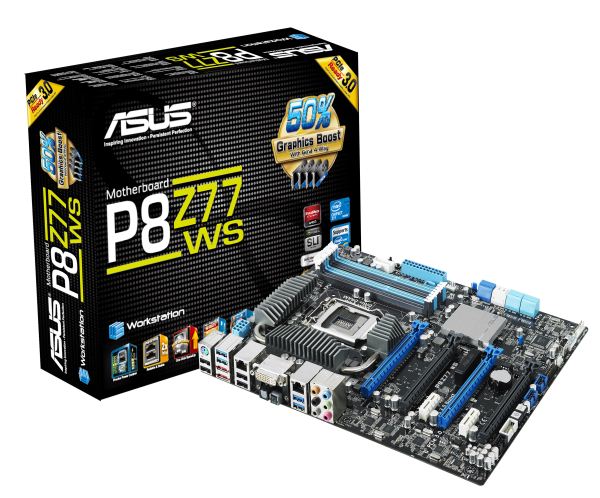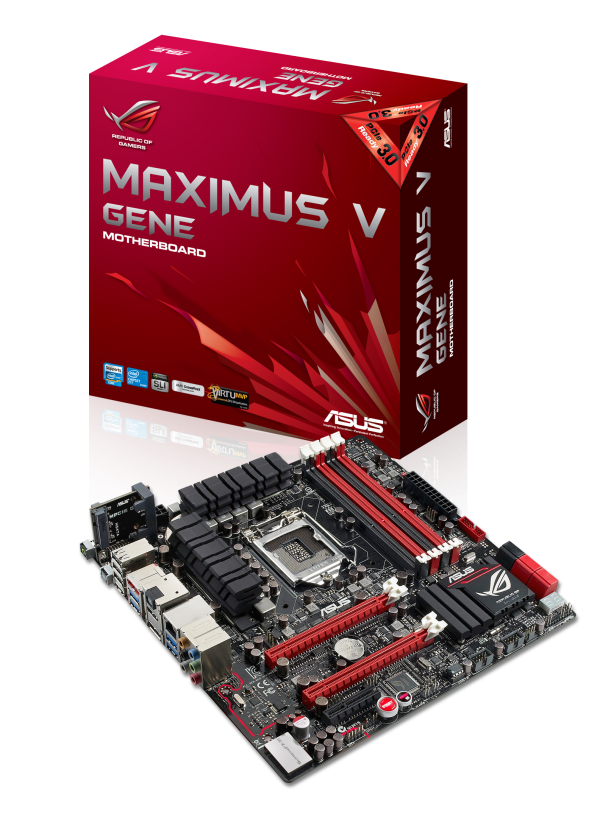A Brief Look at Some Upcoming 7-Series Motherboards
by Ian Cutress on March 9, 2012 5:00 PM EST- Posted in
- Motherboards
- Intel
- H77
- Z77
ASUS
The big motherboard vendors will have at release their usual gamut of motherboards to fit a variety of price points, and ASUS is no exception. The usual lineup from ASUS should consist of several channel board models (LE, -V, Pro, Deluxe, WS, Sabertooth), to then be followed by a variety of Republic of Gamers motherboards (Gene, Maximus, Formula) over the next few months. Today we have images detailing several of these products.
ASUS Sabertooth Z77
The Sabertooth Z77 is part of ASUS’ range of TUF motherboards, supporting an unparalleled level of motherboard cooling control all wrapped up in a five-year warranty. I have been lucky enough to see this board in action, and there are some fun new features to get to grips with: Fan Xpert 2 allows complete fan control, with onboard optimization of fan levels. There is even a feature that allows the fans to keep spinning for a short while after the PC is turned off to remove that stagnant warm air from components.
ASUS P8Z77-V Deluxe
The P8Z77-V Deluxe represents the top end of the ASUS channel board range, and immediately we can see that ASUS is now starting to put on-board Wifi onto these boards. I had a good chat with one of ASUS’ PR, and in their view if at least 25% of their users require a feature, it will be added. Well it turns out that at least a quarter of people according to ASUS use a wireless connection for their PC to get to the internet, and as such this feature should be added across the range. In my eyes, this is a welcome addition which can only add value. The Deluxe also sports Intel network controllers, a feature that works its way down to the other channel boards.
ASUS P8Z77 WS
The WS (workstation) motherboard from ASUS is becoming a staple of their range. This Z77 model, aside from featuring DVI output (rather than HDMI/DisplayPort which the models above do) and dual Intel network controllers, contains a special PCIe 3.0 PLX chip to increase the number of PCIe 3.0 lanes on the motherboard. This gives the PCIe layout to reach x8/x8/x8/x8 all in 3.0 mode, which becomes useful for multi-GPU simulators in increasing GPU-to-GPU throughput. It will be interesting to see if this PLX chip has any performance decrease associated with it like the NF200 did. This WS board supports Intel’s 3rd Generation Intel Core Xeon processors and ECC memory to fit into the workstation category, albeit with more overclock options than a standard workstation board.
ASUS ROG Maximus V Gene
The Gene range of ASUS’ Republic of Gamers boards caters to the crowd wanting small yet powerful systems, with all the functionality of the main size boards (albeit missing a few PCIe ports). The Maximus V Gene doesn’t fail to disappoint – as it has the ROG treatment, we still get access to the ROG forums with dedicated ASUS employees to help optimize any configuration. The port on the IO panel is of interest – this is what ASUS calls an ‘augmentation port’, which provides space for both a mini-PCIe slot and an mSATA port. This would allow users to supply their own wifi module and mini-SSD as required, without taking up valuable space around the rest of the board. Other ROG features include PCB isolation for the audio to reduce electromagnetic interference, and ROG exchange – the ability for users to share overclocking results for similar systems and setups and see exactly all the settings required to make those overclocks.














55 Comments
View All Comments
ComputerGuy2006 - Friday, March 9, 2012 - link
I like how both the ASUS P8Z77 WS and the ASUS P8Z77-V Deluxe have dual NIC. But without a hex core to go with these mobo's look like I am going to be stuck with my slow 1336 till ivy bridge-e....johnpombrio - Saturday, March 10, 2012 - link
Take a look at Anand's review of Ivy Bridge. He uses the SB- E as part of the benchmarking. It turns out that having those 6/12 cores and the extra cache did not make these expensive chips run most stuff any faster than the much less expensive IB. That decided me right there to upgrade to IB rather than to the SB -E chips. So Ivy Bridge with a Z77 chipset is the way to go unless you are doing some serious stuff with transcoding or double or triple SLI..euler007 - Sunday, March 11, 2012 - link
But people on the internets will have more cores than him!lunarx3dfx - Monday, March 12, 2012 - link
My 1366 920 is still hanging in there pretty good, and I was waiting on SB-E to upgrade, but I'm with John. The performance upgrade wasn't significant enough to justify the cost, so it looks like it'll be IB for me. Who cares about 6 or more cores if there isn't a huge performance gain?aguilpa1 - Monday, March 12, 2012 - link
I'm in the same boat, Don't let Intel know but there is usually one GRAND chip that can hold its own against several generations of mediocre chips before an upgrade is needed. The i7 920 when OC'ed is one and the Q6600 was the one before that. I had both and now I'm on the 920 and there doesn't seem to be a good reason to upgrade until IB.Samus - Tuesday, March 13, 2012 - link
I've had an Asus x58 chipset board with a i7-950 for over 3 years, I have upgraded nothing. It is still faster than 90% of the computers on the market, and within 20% of the performance of mainstream Sandy/Ivy Bridge chips.There is no compelling reason to upgrade to Socket 1155 from Socket 1366. I agree with john and lunar in waiting for the next socket/architecture.
Intel really outdid themselves with Bloomfield.
adece - Friday, March 9, 2012 - link
Unless Gygabyte or ASRock puts WiFi on a sub $220 Mobo of their's, my money is going to Asus.deltatux - Friday, March 9, 2012 - link
It would have been nice if ASUS or GIGABYTE would put at least one or two PCI slots. There are still a lot of sound cards and TV tuners that are mainly PCI.It would definitely suck if I am forced to upgrade my sound card which works perfectly just because new motherboards force users to upgrade even though the majority is still on the older tech.
Don't get me wrong, PCI is long overdue to get replaced but honestly, there's still too many of these expansion cards which are still reliant on the older PCI bus.
Concillian - Friday, March 9, 2012 - link
Several Z68 / P67 mobos have PCI slots, will support IB, and should be available for a while.The Z77 chipset has no PCI outputs. It's a little unfair to blame the motherboard makers for not including a feature that is not in the base chipset. It can't be simple to just slap a PCI slot on a mobo with a chipset that is designed not to use them.
DanNeely - Friday, March 9, 2012 - link
Theoretically they could use a PCIe-PCI bridge chip to add a legacy slot; but the cost of doing so (to include the engineering work to integrate it) would probably exceed that of buying a higher end chip from Intel.